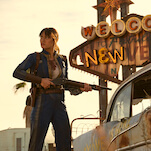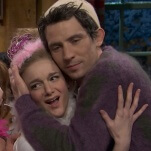How reality becomes a function of film technique in Birdman

Most of us are accomplished watchers of TV and film, so we intuitively understand some of the concepts lurking in dense film-theory tomes. You won’t need them for Internet Film School, The A.V. Club’s column about film and television. In each installment, we explore a basic element of visual composition and analyze examples to understand how the formal properties of film and television manipulate viewers.
In the comments of my previous column, I asked whether there were any particular aspects of modern cinema that you would like addressed. A number of you chimed in with “long takes.” I’m more than happy to oblige—especially since the request coincided with the DVD release of the newly minted “Best Picture” Birdman, a film whose central cinematic conceit is that it was filmed in a single take.
It wasn’t—and if I wanted to be a pedantic bore I’d point out the 14 places in which you can see the seams director Alejandro Gonzalez Iñárritu, cinematographer Emmanuel Lubezki, and editors Douglas Crise and Stephen Mirrione so deftly hid. But before praising these talented individuals for their almost two-hour-long high-wire act, the context in which they accomplished this feat needs a little fleshing out.
As David Bordwell has pointed out, the “average shot length,” or “ASL,” in American cinema has been getting increasingly shorter, such that most Hollywood films now have an ASL between 4 and 6 seconds. Most shots are so short that even films containing notoriously long takes—like Martin Scorsese’s GoodFellas—clock in with an ASL around 7 seconds. All of these short takes make a film “feel faster,” because they constantly present the viewer with new information, such as when a director uses a reaction shot to inform viewers how a character is processing what he or she just heard or saw.
If Person A says “I love you” in a medium close-up and the director cuts to a medium close-up of Person B grimacing, the audience immediately knows how to interpret that reaction because the director’s editing technique signals, “This is a reaction to what was said.” But if the director filmed the same scene with a static medium two-shot of Person A and Person B sitting on a park bench, the audience would be forced to decide whether Person B’s grimace was a reaction to Person A’s statement or to something else, without the short-take shorthand to do thinking for them. In all probability, the meaning of the grimace hasn’t changed—but the director is no longer telegraphing the intended interpretation as forcefully as the reaction shot does.
Which is my own shorthand way of saying that the longer a take is, the more burdened the audience—especially if its members were raised on the conventions of contemporary American cinema—is by the task of interpretation. This becomes apparent as soon as you try to describe what the director of the above hypothetical scene meant to communicate versus what Scorsese wanted the audience to understand about Henry Hill in the Copacabana shot in Goodfellas:
First, Hill is seen tipping the man who opens the back doors for him. Then he greets Gino and tells a couple necking in the hall that “every time I come here, every time you two” are making out. He then demonstrates that he is the kind of person with all-access, familiar with scenes of Asian men arguing in kitchens, as well as beloved by the white staffers and chefs in the back. When he finally makes it into the dining room proper, he gets his own table pulled out of nowhere, again underlying his power—need I continue?
The shot does but I think the point is made—Scorsese allows these various impressions of Hill to gradually accrue. The audience is as overwhelmed as its proxy, Karen, who has been whisked into the club and off her feet. The impression of Hill’s importance is a function of the length of the take—partly because Hill is the central character in it. The mere fact that Scorsese devotes this much uncut screen time to a single character impresses Hill’s importance on the audience. We don’t need to cut to the reaction of Person B, because as Hill wends into the restaurant because there is no Person B of sufficient importance to stop the shot for.












![HBO teases new Euphoria, Larry David, and much more in 2026 sizzle reel [Updated]](https://img.pastemagazine.com/wp-content/avuploads/2025/12/12100344/MixCollage-12-Dec-2025-09-56-AM-9137.jpg)



























